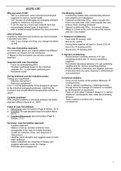Samenvatting
CBT Summary of all lectures, the book, and articles UU - All Exam Material
- Instelling
- Universiteit Utrecht (UU)
This summary contains all the examination material for the course CBT at the UU. Includes images. The articles are extensive and summarized in the normal way (not in two columns). Please note, the first page is representative of the rest of the summary. Lectures: 1 - 5, and 7 Book: Chapters 1 ...
[Meer zien]





